Radiation detection systems
Targeting Radon Daughter and Radon Monitor (TRDRM™)
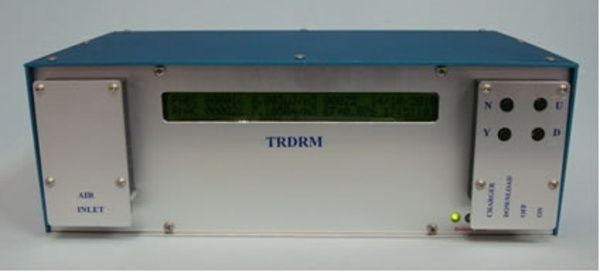
The Targeting Radon Daughter and Radon Monitor is a microprocessor based radiation monitoring system that was developed by Radiation Detection Systems (RDS) for the monitoring of the potential alpha energy concentration (PAEC) of radon daughters and the radon activity concentration (RnAC) in air in parallel with the monitoring of the wind direction and velocity.
The TRDRM is an ideal radon and radon daughter monitor that was designed for a more straightforward and accurate estimate of the impact of a uranium mining project on a critical group of the public as it measures figures that relate to radon released from the project.
The TRDRM is an ideal tool of an underground uranium mine ventilation department that can optimize the mine ventilation more accurately based on the monitored radon equilibrium factor, PAEC, RnAC and the air flow velocity.
The TRDRM would improve the quality of any environmental radiation research into the behavior, origin and fate of radon and radon decay products.
The TRDRM can continuously monitor and log data into the microcontroller memory for about 3 months if a 10 min logging option is chosen. If the 60 min logging option is used the system can continuously gather data for about 1.5 years. Data log is downloaded through the MSWindows/Hyperterminal and opens in Excel ie no special software for the data download is required.
Alternatively, data can be downloaded remotely through an optional radio and/or mobile modem.
Environmental Radon Daughter Monitor (ERDM)
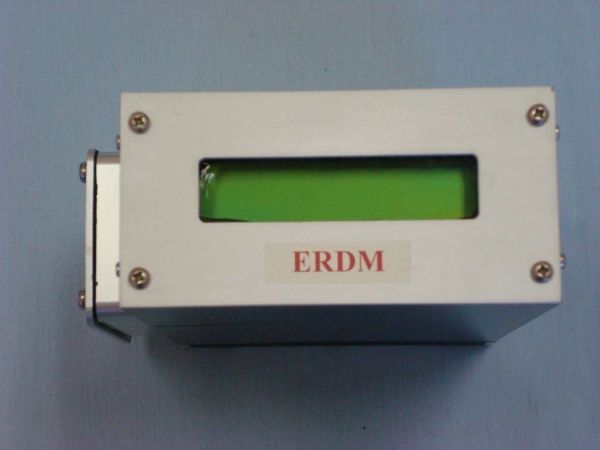
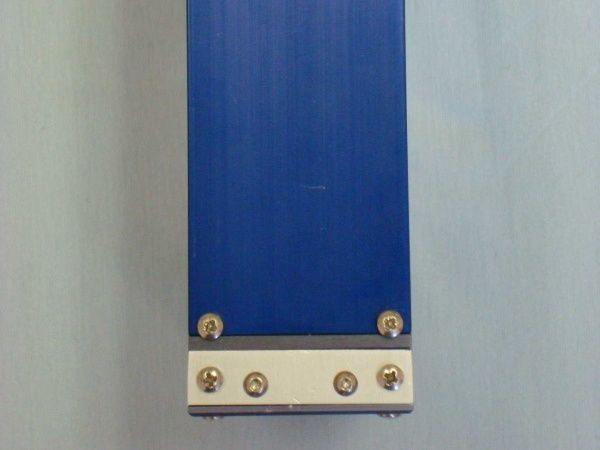
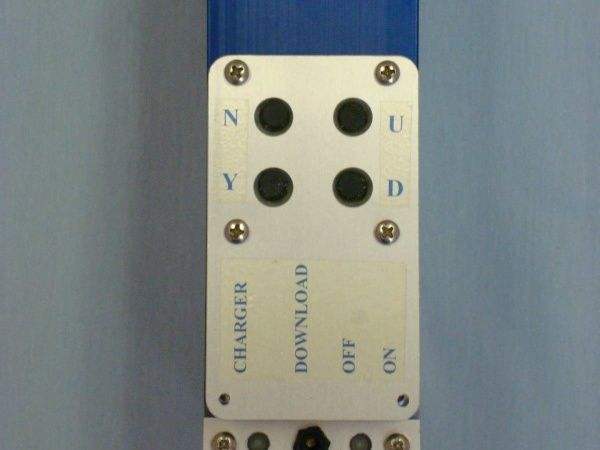
The Environmental Radon Daughter Monitor (ERDM) is a microprocessor based radiation monitoring system that was developed by RDS for the monitoring of the potential alpha energy concentration (PAEC) of radon daughters in outdoor and indoor environments.
The ERDM is powered by an external battery or a 240VAC to DC power adaptor with the output voltage between 7.2 and 14.2V. The ERDM can continuously monitor and log data into the microcontroller memory for about three months if a 10 minute logging option is chosen. If the 60 minute logging option is used the system can continuously gather data for about 1.5 years.
Air with radon daughters is continuously sampled by the constant 0.3 L/min flow rate air sampler. Radon decay products are filtered by the glass fibre filter and alpha particles emitted by radon daughters on the filter are detected by the ZnS(Ag) scintillation foil coupled with a photomultiplier tube. The Lowest Limit of Detection (LLD) of the ERDM is approximately 0.04 microJ/m3.
The ERDM can also be used for sampling of long-lived alpha activity of airborne dust. After completion of the radon daughter monitoring the filter with long-lived dust is removed from the ERDM and alpha counted after a lapse period of no less than 5 days.
Logged data can be downloaded into a MSWindow Hyperterminal as a text file that can be opened in MSExcel.
Spot Radon Daughter Monitor (SRDM)
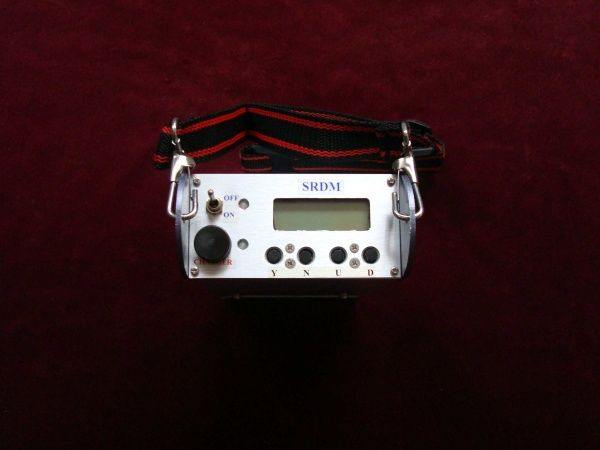
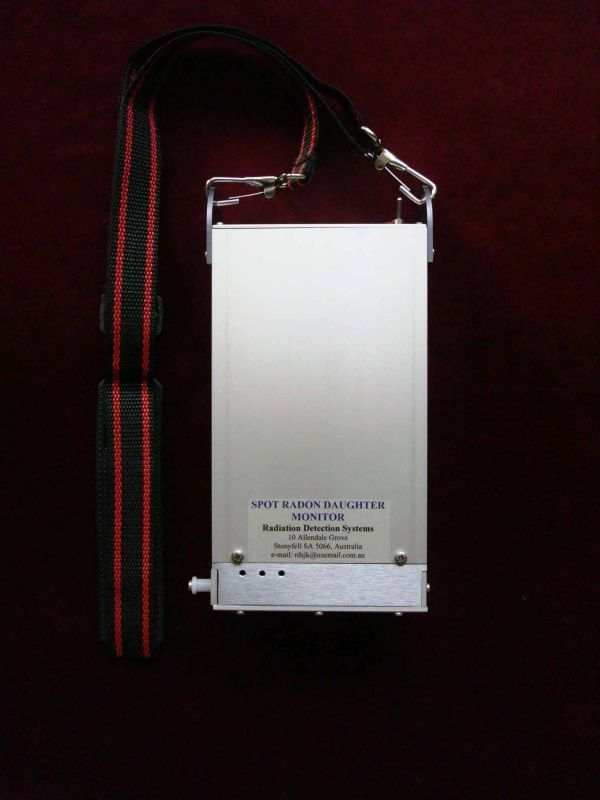
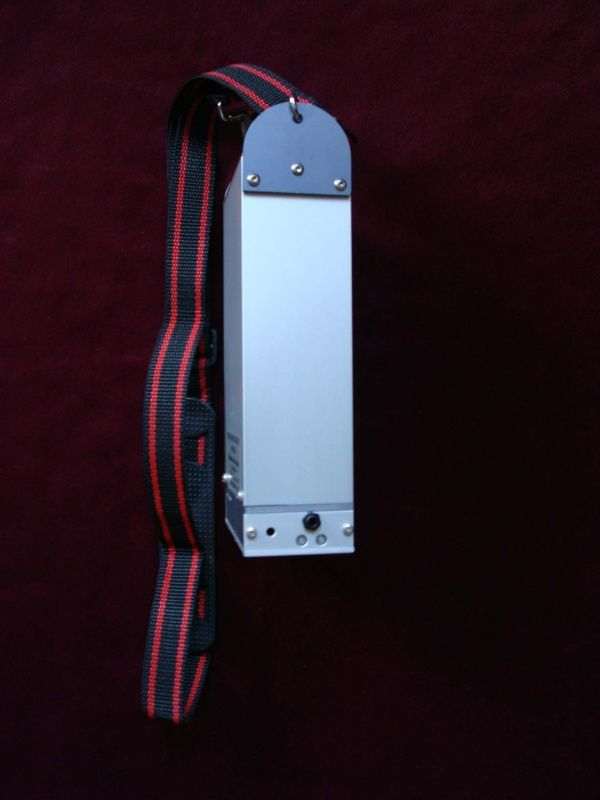
The Spot Radon Daughter Monitor (SRDM) is a fully automatic microprocessor based radiation monitoring system that was developed by RDS for the monitoring of the 'momentary' potential alpha energy concentration (PAEC) of radon daughters in outdoor and indoor environments. The SRDM is powered by an internal battery pack (NiMH-7.2V-1000mAh).
The RDS SRDM adopted the Borak method for the PAEC of radon daughter assessment. The SRDM has an internal air sampling pump, the constant flow rate of which is 2 L/min. Radon daughter aerosols are sampled by a 37 mm glass fibre filter that is in close contact with the ZnS(Ag) scintillation detector. The three minute radon daughter sampling time is followed by the three minute radon daughter decay time before the gross alpha activity of radon daughters on the filter is counted for three minute. When the alpha counting is finished the measured PAEC of radon daughters is displayed on the LCD panel. The Lowest Limit of Detection (LLD) of the SRDM is approximately 0.015 microJ/m3.
Continuous Radon Monitor (CRM)
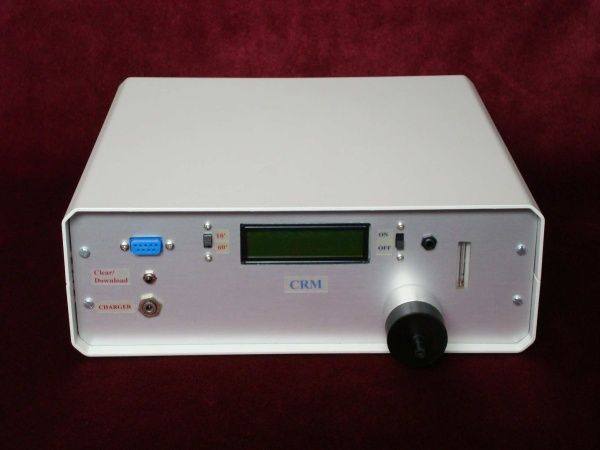
The Continuous Radon Monitor (CRM) is a microprocessor based radiation monitoring system that was developed by RDS for the monitoring of the radon activity concentration in outdoor and indoor air. The CRM connected to the external 12 DC power source can operate continuously for 3 months if a 10 minute logging option is chosen. If the 60 minute logging option is used the system can continuously gather data for about 1.5 years. If short term operation is required the internal battery can support up to 20 hours of continuous monitoring.
Filtered air with radon is continuously sampled by the constant flow rate air sampler. Whilst air flows through the Lucas Cell, alpha particles emitted by radon and radon daughters inside the cell produce scintillations of light within the ZnS(Ag) scintillator coating of the Lucas Cell walls. The light pulses are detected by a Photo Multiplier tube and the voltage pulses are pre-amplified, amplified and logged into a microcontroller memory. The background count is subtracted from the total count and the net count is multiplied by the count to the radon activity concentration conversion factor to obtain the radon activity concentration that is displayed and stored in the memory. The Lowest Limit of Detection (LLD) of the CRM is approximately 5 Bq/m3.
Logged data can be downloaded into a MSWindow Hyperterminal as a text file that can be opened in MSExcel. The net alpha count rate to the radon activity concentration conversion factor is obtained through the system calibration inside the South Australian EPA Radiation Protection Branch Radon Calibration Chamber.
RDS Scintillometer (RDSS)

The RDS Scintillometer is a dual purpose gamma radiation monitor that measures the external gamma count rate (c/s) and the external gamma dose rate (Sv/h) by a 1" x 1" NaI(Tl) scintillation crystal. The scintillometer is used by a geologist to assess a gamma count rate 'signature' of uranium mineralization and/or the gamma count rate of uranium ore cores and ore chip samples. However, it also offers the first level radiation protection information: The geologist is able to estimate the personal gamma radiation dose based on the measured external gamma dose rate.
The gamma count rate (c/s) is displayed either every second or every ten seconds. An external knob is used to switch on the RDS Scintillometer and to engage the one second or 10 s counting interval. A buzzer can be engaged or disengaged by a small panel switch situated behind the bracket under the belt clip.
GPS Scintillometer (GPSS)
The RDS GPS Scintillometer is a dual purpose gamma radiation monitor that measures the external gamma count rate (c/s) and the external gamma dose rate (Sv/h) by a 1" x 1" NaI(Tl). This is typically used by a geologist to assess a gamma count rate 'signature' of uranium mineralization and/or the gamma count rate of uranium ore cores and ore chip samples. However, it also offers the first level radiation protection information: The geologist is able to estimate the personal gamma radiation dose based on the measured external gamma dose rate.
When an external GPS antenna is connected, the reading number, the coordinates and the gamma count rate are logged into the internal memory. The distance in meters between subsequent monitoring/logging positions has to be programmed when the scintillometer is in a programming mode. During a survey it is possible to set an alarm count rate (cps) level by the use of two momentary switches.
Logged data can be downloaded into a MSWindow Hyperterminal as a text file that can be opened in MSExcel.
Low Background Alpha Counter (LBAC)
The RDS LBAC is a small battery operated alpha counter for the alpha counting of 25 mm and/or 37 mm air sampler filter material. The typical alpha counter background is below 0.001 c/s. The alpha counter detection efficiency and the background count rate are programmed into the microcontroller memory. The alpha counting can be carried out in fixed counting windows (100 s, 1000 s and 10000 s), or in a manual counting mode.
When the counting is finished the total count is displayed on the bottom line of the LCD (the total alpha activity on the filter is momentarily displayed when the 'N' switch is pressed). The total alpha activity is calculated considering the total count rate, the background count rate and the counter detection efficiency.